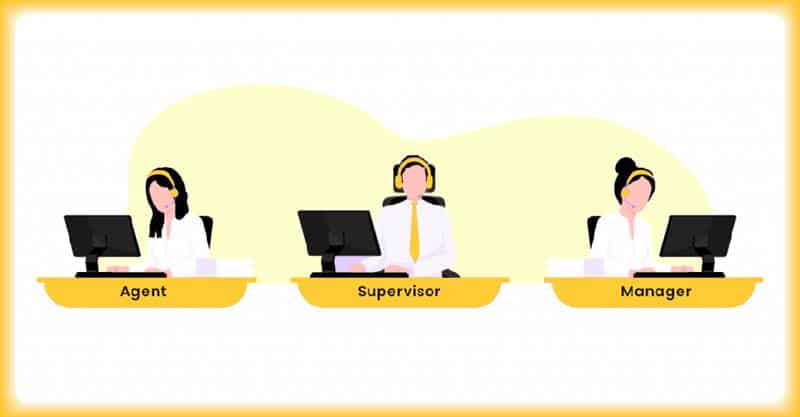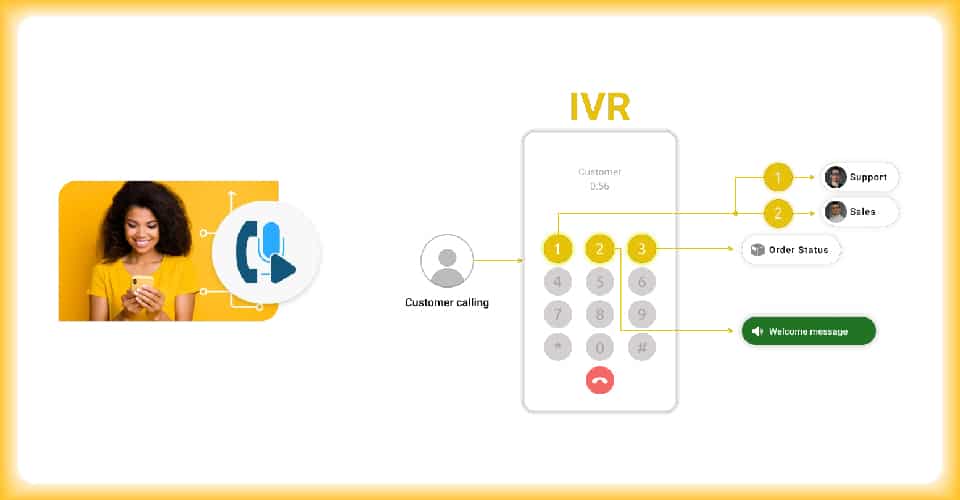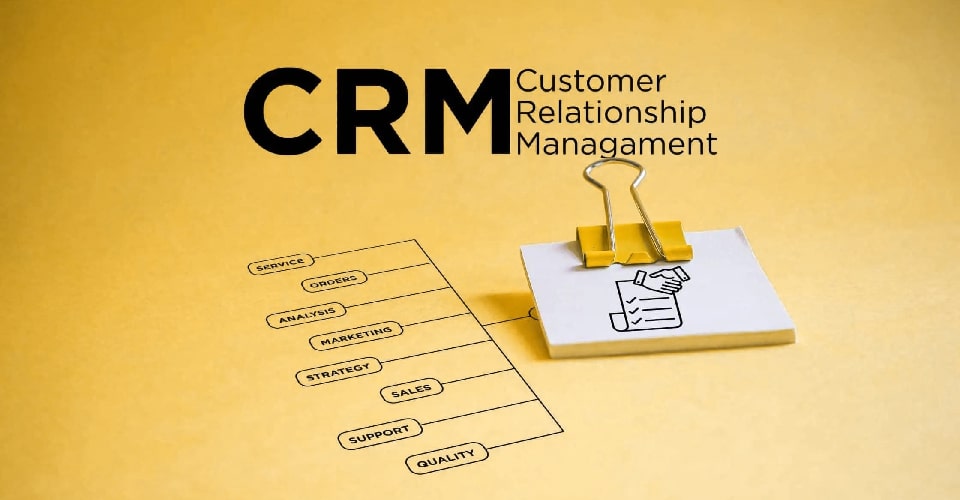
In 2025, the call center industry will have transformed dramatically, and it’s not done yet. Planning a new call center requires you to understand the details of the features offered, not just the buzzwords. Perhaps you’re assessing call center software and want to find out which features are important for your team and, more importantly, your clients value most.
The modern contact center industry has become more efficient, despite the fact that a conventional layout makes us think of long call queues and irate clients. With the use of cloud-based call center technology, companies can now provide contextual customer experiences in a structured way.
According to research.aimultiple, the global market for call centers, valued at $340 billion in 2020, is expected to rise to $500 billion by 2027.
So, we’ve developed a list of the top call center features to consider when designing your new call center system. We’ll also explore how they operate together to provide a consistent customer experience.
Best Call Center Features 2025
- Auto Dialer
- Predictive Dialer
- IVR (Interactive Voice Response)
- ACD (Automatic Call Distribution)
- Skill-based Routing
- Call Monitoring
- Call Recording
- Multiple Dialing Methods
- Call Transfer
- Call Whisper
- CRM Integration
- Call Center Analytics
- Voicemail Transcription
- Real-time Call Reporting
- Pre-call Agent Assist
- Post-Conversation Analytics
- Call logs
- Supervisor Barge-In
- Softphone
- Conversational AI
- Security and Compliance
Why Businesses Need These Features
It is not an overstatement to say that the call center software you employ can have a significant impact on your call center capabilities. Here are a few reasons why you should consider getting the best.
- Hire more people: If your company has recently added a large number of new employees, upgrading to new call center software features can help you stay organized.
- You have more customers. Have you experienced a period of rapid business growth? Feature-rich call center software scales with your business.
- You want to be organized: Struggling with disorganized workflows? New features might help your company stay organized.
- Switch to become a BPO: As a BPO, you will effectively be in charge of providing customer service for others. This means your success is entirely dependent on how successfully you can offer that service.
A poor service experience can drive customers to competitors. Having the best call center features can be beneficial.
What is a Call Center System?

The call center system is a solution that offers advanced features for facilitating phone contact with clients. We divide them into Inbound Call Centers and Outbound Call Centers based on the volume of traffic handled.
Inbound Call Center: An inbound call center handles incoming calls from existing or new customers. Agents of inbound call centers are responsible for monitoring and addressing customer queries to provide technical support.
Outbound Call Center: An outbound call center focuses on reaching out to customers for sales, marketing, lead generation, or following up on previous purchases.
What are the Expectations of Customers?
Customer experience is the only differentiator, and the quality of your customer service may make or break your organization. Organizations place a high priority on customer service and improvement.
However, this is easier said than done. With demanding millennials and Generation Z, customer expectations have shifted, and call center operators must adapt to stay competitive.
So, we must consider which call center features are helpful in this competitive business environment.
21 Must-Have Call Center Features (Explained)
From smarter automation to advanced analytics, here are some important call center features that businesses require to improve communication, increase productivity, and provide great service.
Auto Dialer
The auto dialer automates the dialing procedure and reduces agent idle time with efficient dialing. It dials the numbers from a predefined list and filters out the unproductive and busy numbers. Consequently, the sales team can reach more prospects, skip unanswered calls, and manage customers effectively. Moreover, eliminating the manual dialing increases the call volumes and closes more deals. It is also best for:
- Boost Productivity
- Streamline workflow
- Reduce agent idle time
- Enhance lead conversion rates
Use Case: Helps the sales team to reach more prospects in less time.
Predictive Dialer
A predictive dialer employs an algorithm to determine which phone number should be called next, and by which agent. It effectively uses processing power to make your agents more efficient and effective. Integration with CRM systems provides agents with real-time data on prospects to make conversations more personalized. It is also best for:
- Increase sales
- Reduce operational Cost
- Better customer service
- Improve agent efficiency
- Handle high call volume
You can choose between auto dialing and predictive dialing. Both contribute to the maximum utilization of call center capabilities.
Use case: Travel agencies reach out to travelers with special offers by using a predictive dialer.
Auto Dialer Vs Predictive Dialer
| Feature | Auto Dialer | Predictive Dialer |
| Dialing Mode | Sequential | Algorithm-based |
| Agent Idle Time | Reduced | Minimized |
| Ideal For | Small Campaigns | High-volume Sales Teams |
| Personalization | Limited | Enhanced via CRM Integration |
IVR (Interactive Voice Response)

Interactive Voice Response (IVR) is another important feature of call center operations. IVR allows callers to specify their preferences using voice responses. This enables inquiries to be answered without someone speaking to callers (such as during office hours).
For example, “Press one for sales, two for support” demonstrates IVR in action. IVR, a common component in contact centers, enhances navigation and reduces response times. This is the best call center feature to handle high call volumes.
Use case: Telecom companies using IVR for service activations.
ACD (Automatic Call Distribution)
Automatic call distribution is a must-have feature of call centers. This system automatically routes calls based on predefined factors such as caller ID, operating hours, assistance level, and IVR choices. For example, when a customer calls the sales team, the ACD system recognizes this according to predefined parameters and directs the call to the appropriate department.
ACD systems act as an equalizer for businesses looking to balance their agents’ workload. By incorporating the ACD feature into your call center system, you can protect agents from performance burnout and retain their productivity.
Use case: Financial institutions directing customers to specialists in loans, investments, or accounts.
Skill-based Routing
Customer support representatives work based on their skills, which can include their experience, language knowledge, and skill set. In an omnichannel contact center system, skill-based routing is a critical element that directs customers to the most suited customer support agent for specific situations.
For example, a French-speaking customer phoned the call center seeking help with network troubles. Connecting him with a non-technical Chinese-speaking agent will lead to a negative customer experience. Skill-based routing eliminates such scenarios and enables seamless routing.
Use case: Helps BPOs handle multilingual customer queues efficiently.
Call Monitoring
Real-time monitoring enables supervisors to see active calls, providing agents with rapid feedback and assuring service quality. For example, a manager can listen in on a live call and provide advice via a private chat. So, it’s a critical element of call center solutions that assures consistent customer experiences. This feature is also best for:
- Improve overall service quality
- Detect and address issues during calls
- Better understanding of customer needs
Use case: Sales reps fine-tuning pitches with live guidance from experienced team members
Call Recording
Call recording is the most fundamental aspect of VoIP. It’s an essential call center feature, and if you don’t currently have it, you should. This enables you to record incoming calls (if you operate an inbound call center) or outgoing calls. You can then save these recordings and access them later.
Use case: Helps managers identify areas of improvement.
Multiple Dialing Methods
You will be surprised to know that sales representatives spend nearly 65% of their time on administrative tasks, which puts their key tasks on hold. This is why they require a solution that can handle mundane activities like dialing and data management. So that they can focus on having excellent Conversations.
Modern call center software provides a variety of dialing methods to suit different campaign objectives and lead categories. These calling options are:
- preview dialing, which allows agents to examine customer information before making a phone call.
- predictive dialers, which utilize algorithms to dial several calls and connect answered calls to free agents.
- progressive dialers, which automatically dial numbers one at a time when agents become available.
Call centers may increase efficiency, enhance lead engagement, and launch more intelligent, focused campaigns by providing a variety of dialing options.
Use case: Helps BPOs to personalize calls according to industry type.
Call Transfer
A fundamental component of modern phone systems since their beginning has been the ability to transfer calls. But as businesses have grown in size and geographic reach, it has become an increasingly more crucial component of call center systems.
Both cold and warm call transfers are permitted by VoIP providers. Cold (from the phrase “going in cold”) refers to the practice of unexpectedly transferring a call to an individual without first checking in with them. Before performing the transfer, the latter, warm, enables one agent to get in touch with another.
Call Whisper
A form of call monitoring called “call whispering” lets the manager hear what’s going on throughout the call. One significant distinction is that supervisors can talk to the agent (or “whisper”) while the call is still in progress without the person on the other end of the line hearing.
Managers use this feature to teach new agents or assist seasoned ones in closing deals. As an alternative, they can just decide to listen.
Use case: Enables real-time agent coaching without interrupting the customer interaction.
CRM Integration

CRM stands for customer relationship management. Different phone systems offer different integrations such as, integrate with HubSpot, Zapier, Zendesk, and more. Almost every call center system includes a CRM integration to enable agents to provide tailored experiences. The technology provides agents with data such as customer names, ticket types, chat transcripts, and so on.
Such crucial information helps agents work in an effective and structured manner and deliver relevant solutions to customers.
Use case: Sales teams reviewing customer purchase histories to upsell or cross-sell.
Call Center Analytics
With the complexity of running a contact center, assuring functionality is important. An overview is a fantastic approach to accomplish this. These call center capabilities give you an overview of everything going on in your center: calls made, calls missed, call time, who is talking, when they talked, and so on.
Use case: Identifying common customer issues for further training.
Voicemail Transcription
Voicemail-to-email is one of the most significant functionalities of call center software. It provides major benefits to agents and promotes departmental success. Call center agents can get voicemails immediately in their email inbox and letting them to respond to client concerns quickly.
If an agent misses a call, voicemail transcription ensures they receive key details by email, enabling faster follow-up and improved responsiveness.
Use case: Marketers convert audio to text during market research.
Real-time Call Reporting
Real-time monitoring provides detailed insights into agent-customer interactions as well as a number of service-level metrics such as average call wait time, maximum wait time, average handling time, and the average number of available agents.
Moreover, real-time call monitoring enables investors to make better decisions that are consistent with the organization’s objectives. The data can also be utilized to make strategic decisions, increase call center system efficiency, and improve client experiences.
Use case: Helps call centers optimize agent shifts and staffing based on peak call times.
Pre-call Agent Assist
Agents frequently experience information overload or a lack of context during live interactions. Pre-Call Agent Assist (AI-driven feature) is a contact center feature that addresses this issue. It provides real-time recommendations, contextual data, and next-best actions based on CRM systems and previous interactions.
This reduces the average handling time and increases first-call resolution. Moreover, it personalizes conversations so that customers feel understood and valued.
Post-Conversation Analytics
Customer chats can provide valuable insights, but only if you know where to look. AI-powered call center services, such as post-call analytics, provide detailed insights into sentiment, agent performance, and compliance issues. It assists in identifying customer sentiment, compliance issues, and agent performance gaps.
Call logs
It makes sense for a call center to have all of its calls in one place. That’s why call logs are an important call center feature. A call log can help your agent recall who and when they called someone, and when shared with others, it can smooth out changes such as work shifts.
Use case: Agents quickly access customers previous interactions and personalize individual needs with call logs.
Supervisor Barge-In
This feature allows the supervisor to take control of the live call. So, this is beneficial for training agents, handling difficult calls, and improve call quality. It allows a supervisor to “intercept” the call and speak directly with the caller, while the original agent is either disconnected or placed on hold.
Use case: Help supervisors to assist agents and train them, or take over a call if necessary.
Softphone
Softphones allow agents to access call queues from anywhere, whether they work from home or between offices.
Your agents may make and receive calls, communicate with internal colleagues, and use services like call forwarding and conference calling from your softphone software, whether on a computer or a mobile phone. Moreover, they can receive real-time notifications and have access to the same services as they would at work.
Use case: Help healthcare companies to conduct remote consultations.
Conversational AI
Conversational AI transforms the call center industry. With automated customer support, we can handle more customer interactions, boosting customer satisfaction. Conversational AI technologies like Voice bot and chatbots use natural language processing to handle customer inquiries without any human intervention.
So, this technology increases accessibility by providing 24/7 customer support. Globally, the conversational AI market is expected to grow 22% between 2020 and 2025, with the market reaching nearly $14 billion by 2025. (Deloitte)
Use case: AI chatbot and Voice bot deliver 24/7 customer support.
Security & Compliance
Call centers frequently handle sensitive customer data; therefore, security is a main consideration. Your call center system should prioritize privacy features and adhere to applicable industry requirements.
HIPAA, CCPA, and PCI DSS: Make sure that your call center solution complies with these and other applicable requirements, particularly if you process health or financial data or operate in specific geographic zones.
End-to-end encryption: protects calls against snooping while in transit and at rest.
Regular security audits: Perform regular security assessments and penetration testing to proactively detect and address vulnerabilities.
Use case: Healthcare call centers ensuring HIPAA compliance in patient interactions
How to Choose the Perfect Features
Choose the right features according to your business needs and goals. However, one must consider the following factors:
Industry Type: Every industry has different requirements.
Call Volume: You must know the call volume of your call center. High call volume requires features like workforce management and call routing.
Customer Expectations: Are your clients expecting self-service options? Do they prefer to interact across numerous channels?
Business Goals: Do you want to improve customer satisfaction, increase sales, cut costs, or all of the above?
Budget: The Call center solution cost depends on the number of users and features.
Conclusion
Choosing the right call center features is critical for delivering world-class customer service. From AI integration to smart dialer, all features empower your team to boost productivity and create meaningful customer connections. Evaluate your current setup and prioritize the features that align with your customer service goals for 2025.



